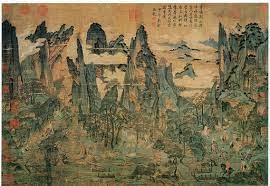Landscape Paintings: The History of Technique

Landscape paintings, what many people also call by the name of landscape art- are known to depict nature and natural sceneries such as mountains, rivers, forests, valleys, etc. In such kinds of paintings- the main element of focus is the wide view range that an artist works hard to showcase.
In most of the landscape paintings and other abstract canvas paintings, the elements are arranged into a coherent composition. While the background plays an important role – the sky is almost included in all kinds of landscape paintings. Weather is also an important element- that holds and sets the mood of the painting altogether.
Landscapes as a unique subject are not found in all creative traditions, and they emerge when a sophisticated tradition of painting other subjects already exists.
Western painting and Chinese art both have two major traditions that date back over a thousand years. The acknowledgment of a spiritual aspect in landscape art may be traced back to East Asian art, which draws on Daoism and other intellectual traditions, but it is only with Romanticism that it becomes clear in the West.
A Little About the Rise of Landscape Paintings
It are known to be one of the oldest forms of art. The earliest forms of the same had no image or portrayal of human figures and are known as Fresco- from the Minoan Art- first found in 1500 BCE. The later ones had a clear interference of mountains, trees, and naturally available features.
One can also see the Hunting scenes. Those enclosed with the reed beds of Nile Delta from Egypt- giving a true sense of the place just with the help of an image. While such paintings hold great significance, the emphasis was always on the plant form, humans, and animals individually.
A rough system of perspective, or scaling for distance, is required for a coherent depiction of an entire landscape, and this appears to have been devised in Ancient Greece during the Hellenistic period, according to literary evidence, though no large-scale examples survive.
From the 1st century BCE onwards, more ancient Roman landscapes survive, particularly frescoes of landscapes decorating rooms that have been preserved at archaeological sites such as Pompeii, Herculaneum, and elsewhere, as well as mosaics.
While landscape painting in the West had a low position in the accepted hierarchy of genres until the 19th century, it was traditionally the most prestigious form of visual art in East Asia, where the classic Chinese mountain-water ink painting was the most prestigious form of visual art. Aesthetic ideas in both regions regarded the works that required the most imagination from the artist as having the highest status.
This was history painting in the West, but it was the imagined landscape in East Asia, whose prominent practitioners were, at least in theory, amateur literati, including several Chinese and Japanese Emperors. They were frequently poets whose phrases and imagery illustrated their ideas.
Landscape Paintings In The Era Of Renaissance
During the 15th century, landscape paintings and their backgrounds for many forms of painting became more popular and skilled. Pure landscape drawings and watercolors were produced by Leonardo da Vinci, Albrecht Dürer, Fra Bartolomeo, and others around the end of the 15th century. But pure landscape subjects in painting and printmaking were first produced in the early 16th century by Albrecht Altdorfer and others of the German Danube School.
The outsides of the wings of a triptych by Gerard David, dated “about 1510-15,” are the earliest from the Low Countries, if not Europe. At the same period, in the Netherlands, Joachim Patinir produced the “world landscape,” a style of panoramic landscape with small figures and a high aerial viewpoint that was employed and polished by Pieter Brueghel the Elder and stayed prominent for a century.
The Italian development of a sophisticated method of pictorial perspective, which allowed big and complicated views to be painted very efficiently, was now known across Europe.
Landscapes were idealized, mostly reflecting a pastoral ideal drawn from classical poetry, which was first fully expressed by Giorgione and the young Titian, and remained associated above all with hilly wooded Italian landscapes, which were depicted by Northern European artists who had never visited Italy, just as plain-dwelling literati in China and Japan painted vertiginous mountains.
Whilst the young artists were inspired to take a tour of Italy in order to learn the best they could, the Northern Europe Artists made a living by selling Italianated landscape paintings and abstract canvas painting. The styles being so popular- were copies again and again!
These were frequently real sights, however, the compositions were occasionally tweaked for aesthetic effect.
The paintings were inexpensive to manufacture but took a long time to complete. These artists may supplement their income by training “armies of amateurs” to paint alongside them.
Wrap up:
If you are reading this line- you have added a lot to your knowledge today. While you cherish the knowledge, get yourself the treat you deserve! Buy great abstract canvas paintings at affordable prices from Indian Art Ideas. They hold in a great set of paintings for your personal and professional space.




